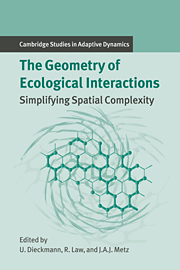Book contents
- Frontmatter
- Contents
- Contributing Authors
- 1 Introduction
- Part A Empirical and Statistical Background: A Plant Ecological Perspective
- Part B When the Mean-field Approximation Breaks Down
- Part C Simplifying Spatial Complexity: Examples
- Introduction to Part C
- 12 Spatial Scales and Low-dimensional Deterministic Dynamics
- 13 Lattice Models and Pair Approximation in Ecology
- 14 Moment Approximations of Individual-based Models
- 15 Evolutionary Dynamics in Spatial Host–Parasite Systems
- 16 Foci, Small and Large: A Specific Class of Biological Invasion
- 17 Wave Patterns in Spatial Games and the Evolution of Cooperation
- Part D Simplifying Spatial Complexity: Techniques
- References
- Index
- International Institute for Applied Systems Analysis
17 - Wave Patterns in Spatial Games and the Evolution of Cooperation
Published online by Cambridge University Press: 14 January 2010
- Frontmatter
- Contents
- Contributing Authors
- 1 Introduction
- Part A Empirical and Statistical Background: A Plant Ecological Perspective
- Part B When the Mean-field Approximation Breaks Down
- Part C Simplifying Spatial Complexity: Examples
- Introduction to Part C
- 12 Spatial Scales and Low-dimensional Deterministic Dynamics
- 13 Lattice Models and Pair Approximation in Ecology
- 14 Moment Approximations of Individual-based Models
- 15 Evolutionary Dynamics in Spatial Host–Parasite Systems
- 16 Foci, Small and Large: A Specific Class of Biological Invasion
- 17 Wave Patterns in Spatial Games and the Evolution of Cooperation
- Part D Simplifying Spatial Complexity: Techniques
- References
- Index
- International Institute for Applied Systems Analysis
Summary
Introduction
Our understanding of the evolution of animal behavior has been greatly enhanced by the use of game theory (Maynard Smith 1982). Classical games assume that a given individual is equally likely to interact with any other member of the population and that the success of any individual depends on the frequency of all other strategies represented in the population. Yet natural environments possess a spatial dimension: individuals have limited mobility and interact locally with their neighbors. Only recently have attempts been made to incorporate this important property into the study of evolutionary games. Different approaches have been followed: numerical simulations of “games on grids” (Nowak and May 1992; Lindgren and Nordahl 1994; see Chapter 8); analytical study of correlation equations for games on lattices (Nakamaru et al. 1997; see Chapter 13); and analytical study of “replicator-diffusion” equations (e.g., Vickers 1989; Vickers et al. 1993; Ferrière and Michod 1995, 1996; see Chapter 22). In this chapter we restrict ourselves to the last of these methodologies and provide an introduction to its mathematical underpinnings and biological applications. Elements of a general theory of replicator–diffusion equations are expounded in detail in articles by Vickers (1989), Hutson and Vickers (1992), Vickers et al. (1993), and Cressman and Vickers (1997). We present an overview of these important results in Section 17.2. Sections 17.3 and 17.4 show how replicator–diffusion models can be used to study spatial versions of the iterated Prisoner's Dilemma game, a well-known metaphor for evolution toward cooperation between genetically unrelated individuals (Trivers 1971; Axelrod and Hamilton 1981; Maynard Smith 1982; Hofbauer and Sigmund 1998).
Information
- Type
- Chapter
- Information
- The Geometry of Ecological InteractionsSimplifying Spatial Complexity, pp. 318 - 336Publisher: Cambridge University PressPrint publication year: 2000
Accessibility standard: Unknown
Why this information is here
This section outlines the accessibility features of this content - including support for screen readers, full keyboard navigation and high-contrast display options. This may not be relevant for you.Accessibility Information
- 2
- Cited by
